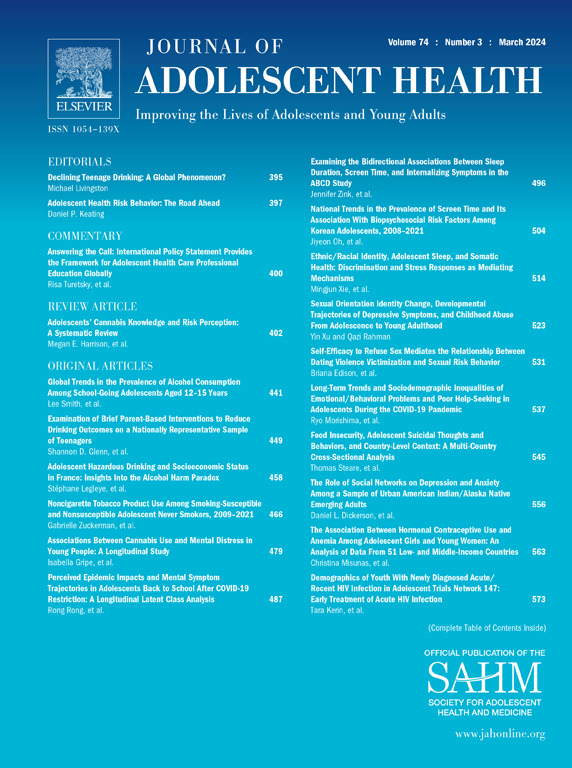How Are Extended Reality Technologies Being Used for Behavioral Prevention and Health Promotion With Children and Adolescents? A Scoping Review
IF 5.5
2区 医学
Q1 PEDIATRICS
引用次数: 0
Abstract
In prevention and health promotion with children and adolescents, extended reality (XR) technologies (including virtual reality, augmented reality, augmented virtuality, and mixed reality) are of interest, as they were shown to enhance learning in educational contexts. However, unlike in clinical research, there is no clear overview of its use for these purposes. Therefore, this scoping review provides an overview of XR in behavioral prevention and health promotion in childhood and adolescence. For this purpose, 10 databases were systematically searched for relevant entries, combined with outreach to professional societies and associations, and experts in the field. As a result, 27 reports were included that describe XR applications (mostly virtual reality) in different areas of prevention (e.g., substance use, violence, emotion regulation, road/fire/water safety). XR is often co-created through participatory action and seems to achieve good acceptance and feasibility, yet most studies so far are pilot studies with small and selective samples with mixed results. Although participatory research principles were often implemented, many dimensions of health equity and public health impact were also not considered. In conclusion, XR may be promising for behavioral prevention, but more rigorous efficacy studies using larger, representative samples and longitudinal observations are urgently needed to advance the field.
扩展现实技术如何用于儿童和青少年的行为预防和健康促进?范围审查。
在儿童和青少年的预防和健康促进方面,扩展现实(XR)技术(包括虚拟现实、增强现实、增强虚拟性和混合现实)引起了人们的兴趣,因为这些技术被证明可以提高教育背景下的学习效果。然而,与临床研究不同的是,目前还没有关于 XR 技术用于这些目的的明确概述。因此,本范围综述概述了 XR 在儿童和青少年行为预防和健康促进方面的应用。为此,我们系统地搜索了 10 个数据库中的相关条目,并联系了专业学会和协会以及该领域的专家。结果,共收录了 27 份报告,介绍了 XR 在不同预防领域(如药物使用、暴力、情绪调节、道路/火灾/水安全)的应用(主要是虚拟现实)。XR 通常是通过参与式行动共同创建的,似乎取得了良好的接受度和可行性,但迄今为止的大多数研究都是小规模和选择性样本的试点研究,结果好坏参半。虽然参与式研究原则经常得到贯彻,但许多健康公平和公共健康影响方面的问题也没有得到考虑。总之,XR 在行为预防方面可能大有可为,但要推动这一领域的发展,迫切需要使用更大、更有代表性的样本和纵向观察进行更严格的疗效研究。
本文章由计算机程序翻译,如有差异,请以英文原文为准。
求助全文
约1分钟内获得全文
求助全文
来源期刊

Journal of Adolescent Health
医学-公共卫生、环境卫生与职业卫生
CiteScore
10.40
自引率
3.90%
发文量
526
审稿时长
46 days
期刊介绍:
The Journal of Adolescent Health is a scientific publication dedicated to enhancing the health and well-being of adolescents and young adults. Our Journal covers a broad range of research topics, spanning from the basic biological and behavioral sciences to public health and policy. We welcome a variety of contributions, including original research papers, concise reports, literature reviews, clinical case reports, opinion pieces, and letters to the editor. We encourage professionals from diverse disciplines such as Anthropology, Education, Ethics, Global Health, Health Services Research, Law, Medicine, Mental and Behavioral Health, Nursing, Nutrition, Psychology, Public Health and Policy, Social Work, Sociology, and Youth Development to share their expertise and contribute to our mission of promoting adolescent health. Moreover, we value the voices of young individuals, family and community members, and healthcare professionals, and encourage them to submit poetry, personal narratives, images, and other creative works that provide unique insights into the experiences of adolescents and young adults. By combining scientific peer-reviewed research with creative expressions, our Journal aims to create a comprehensive understanding of the challenges and opportunities in adolescent and young adult health.
 求助内容:
求助内容: 应助结果提醒方式:
应助结果提醒方式:


